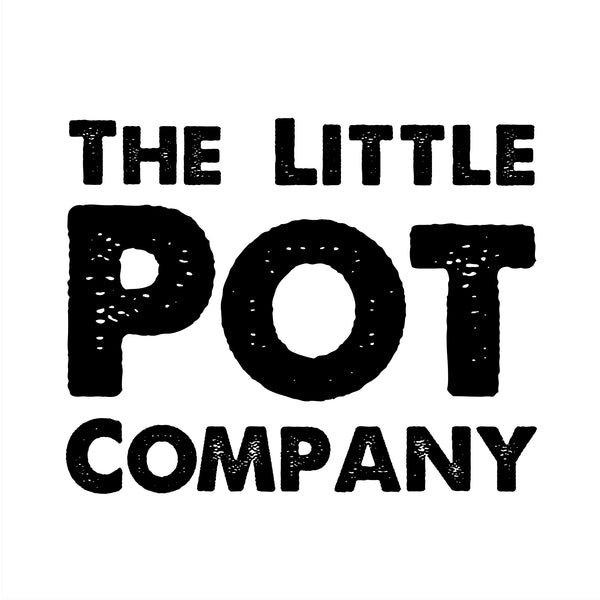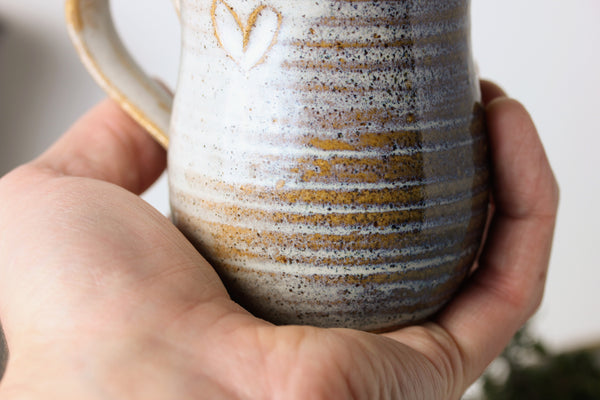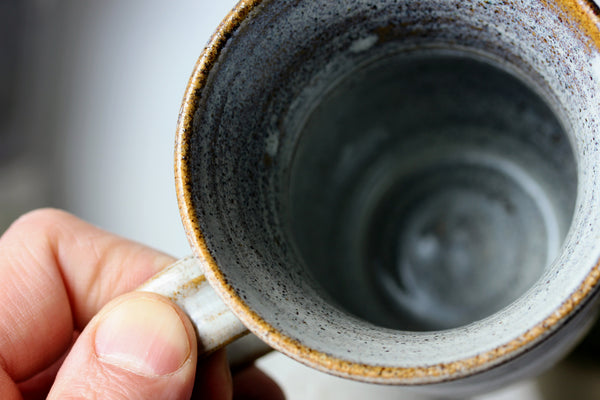What Makes The Perfect Handmade Mug? How Big & Why Handmade?
Share
Your favourite mug is possibly one of your most treasured possessions. What exactly is it that makes you love it so much?
In this article I'll try and pin down what I think makes the perfect mug. I'd love to hear about your favourite features, and hopefully I can improve my making in the future.
What is the best mug size?
Whilst designing my mug and cup collection I've done pretty extensive research on mug sizes. The first mugs I ever made ended up like Hobbit mugs - newbie potters often forget to take clay shrinkage into account.
Now I make most of my mugs to around 12 oz / 350 ml, taking shrinkage into account. I've found this size to be the most popular, and many standard mugs are around this large. It's also the size of a standard can of soft drink, so there must be something about the human thirst that finds this size adequate.
When using mugs for drinking tea, the size is very important. Too big and the tea ends up being too watery and weak, too small and you don't have enough to drink. For tea I find the 12 oz size is just right.
For coffee mugs the size is very dependent on the coffee type, obviously you wouldn't want to be drinking espresso from a massive mug. The most popular coffee cups I sell are the espresso and 6 oz cups, but I often have a 12 oz Latte which I think is the best mug size.
Can a mug affect the taste of tea or coffee?
A friend told me that their partner will only ever drink from a mug with a white interior. I found this a little strange, I don't really have such strict rules to my life.
However, during my research for this article I found some evidence that the mug colour can effect the taste. This article suggests that with white mugs, the flavour was perceived to be more intense. Apparently the contrast in colour between the coffee and white mug affects the perceived intensity and sweetness of the coffee.
The material the mug is made from is very important.
Plastic mugs are possibly the worst option in my opinion. The plastic can absorb tastes, so coffee made one time can impart its flavour to your tea the next time. Certain types of plastic are not currently recycled, and they don't really look or feel very nice.
Stainless steel is durable and probably the best option if you are going for a hike or doing some white water rafting while having a brew. These types of mugs do give a bit of a metallic taste to your drink though. This can be reduced by giving your mugs a thorough wash before filling with your drink.
Glass mugs are one of the best types for maintaining the optimum taste of your coffee or tea. They don't retain heat very well though and the look of them is limited to, well looking like glass.
So ceramic mugs are definitely the best! They maintain the perfect taste of your drinks, neither absorbing or adding anything to the taste. They act as natural insulators to keep your drink warm for longer and they also look pretty!
I would say that because I make them, but if you do a quick search you'll find lots of evidence that agrees.
Are Handmade Mugs Better?
So far the 12 oz ceramic mug seems to be the best option. The last choice is whether to buy a mass produced or handmade mug.
The obvious benefits of mass production is the cost savings. Industrial glazes have been formulated to produce a consistent finish. The glazes are usually quite flat looking, the same all over. They are often kiln fired very quickly to keep costs down.
Glazes on handmade mugs, especially ones fired in open flames usually have a much more varied character. The mug can be different colours on different sides depending on how the flame has travelled around it in the kiln. The glaze may also give different colours when decorations are carved into the pot. The long glaze firings of studio potters allows the glaze to develop beautifully at its own pace.
Wheel thrown mugs often exhibit the faint throwing lines left where the potter has pulled the clay upwards on the wheel. This is another nice reminder that your mug has been made by another human, not on a production line. This is a traditional making method that has been ongoing for hundreds of years. Buying handmade mugs means you are investing in people, not just pottery.
If you would like to see some example of my work please have a look at my handmade mugs section of this website. You could find some other great potters who produce mugs on my post about my favourite potters on Instagram.
Don't forget to leave a comment about what makes the perfect mug for you!


